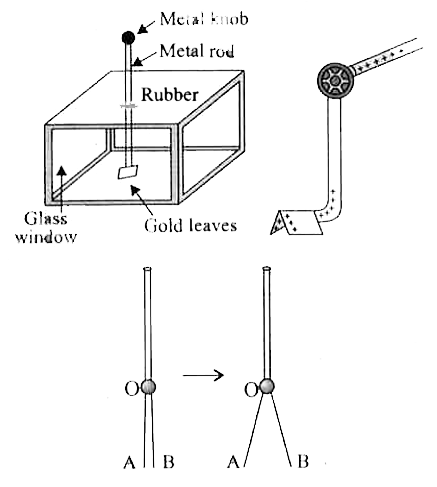If you bring a charged rod near dry cork dust, the rod attracts cork dust and then on touching the rod these cork dust particles are repelled away from the rod. Explain it.
Charged rod attracts the cork dust particles due to induction of opposite charge on the nearby particles. Opposite charge on the particles being near charged rod, they are attracted. But on touching the rod they also receive some amount of charge carried by rod, which is of the same polarity as that of the charge on the rod. Thus, these particles are repelled away due to repulsion between like charges
Topper's Solved these Questions
- BOOK - MODERN PUBLICATIONCHAPTER - ELECTRIC CHARGES AND FIELDS EXERCISE - Tough & Tricky Problems20videos
ELECTRIC CHARGES AND FIELDS
- BOOK - MODERN PUBLICATIONCHAPTER - ELECTRIC CHARGES AND FIELDS EXERCISE - Ncert File (Textbook Exercise)34videos
ELECTRIC CHARGES AND FIELDS
- BOOK - MODERN PUBLICATIONCHAPTER - ELECTRIC CHARGES AND FIELDS EXERCISE - Practice Problems88videos
ELECTRIC CHARGES AND FIELDS
- BOOK - MODERN PUBLICATIONCHAPTER - DUAL NATURE OF RADIATION AND MATTER EXERCISE - CHAPTER PRACTICE TEST15videos
DUAL NATURE OF RADIATION AND MATTER
- BOOK - MODERN PUBLICATIONCHAPTER - ELECTROMAGNETIC INDUCTIONEXERCISE - CHAPTER PRACTICE TEST FOR BOARD EXAMINATION14videos
ELECTROMAGNETIC INDUCTION
Similar Questions
A charged rod attracts bits of dry paper, which after touching the rod often jucp away from it rapidly, Expalin
View SolutionA metal sphere is suspended from a nylon thread. Initially, the metal sphere is uncharged. When a positively charged glass rod is brought close to the metal sphere, the sphere is drawn towards the rod. But if the sphere touches the rod, it suddenly flies away from the rod. Explain, why the sphere is first attracted then repelled?
View Solution
Knowledge Check
- Question 1 - Select One
The negatively charged dust particles are attracted by
AElectrode wiresBDischarge coronaCCollection platesDAll of the above - Question 2 - Select One
When a charged rod is brought near small bits of paper, the small bits will
ABe repelled by the rodBStick firmly to the rodCAttach itself to the rod at first and then fly offDRemain unaffected. - Question 3 - Select One
A girl brings a positively charged rod near a thin neutral stream of water from a tap. She observes that the water stream bends towards her. Instead, if she were to bring a negatively charged rod near to the steam, it will–
ABend in the same directionBBend in the opposite directionCNot bend at allDBend in the opposite direction above and below and rod
Why does the paper strip open up when touched with a charged rod?
View SolutionA triangle is made from thin insulating rods of different lengths, and the rods are uniformly charged, i.e. the linear charge density on each rod is uniform and the same for all three rods. Find a particular point in the plane of the triangle at which the electric field strength is zero
View SolutionWhat is the correct order of following steps for an experiment to prove that like charges repel each other?
(A) Take two galss rods.
(B) Now bring these two charged rods nearer.
(B) Now bring these two charged rods nearer.
(C) Charge them by rubbing each glass rod with a silk cloth.
(D) The glass rods equal other showing that like charges repel each other.View SolutionA leaf electroscope is a simple apparatus to detect any charge on a body. It consist of two metal leaves OA and OB, free to rotate about O. Initially both are very slighty separted. When a charged object is touched to the metal knob at the top of the conduction re, charge flows from knob to the top of the conduction rod, charge flows from knob to the leaves through the conducting rod, charge flows from knob to the leaves through the conduction rod. As the leaves are now charged similarly, they start repelling each other and tet separted (deflected by certain angle).

The angle of deflection in static equilibrium is an indicator of the amount of charge on the charged boy.
When a+20C rod is touched to the knob, the deflection of leaves was 5∘, and when an identical rod of −40C is touched, the deflection was found to be 9∘. If an identical rod of +30C is touched, then the deflection may be:View SolutionWrite the following steps in sequential order to prove that like charges repal each other.
(A) Take two glass rods.
(B) Now bring these two charged rods nearer.
(C) Charge them by rubbing each glass rod with a silk cloth.
(D) The glass rods equal other showing that like charges repel each other.View Solution

